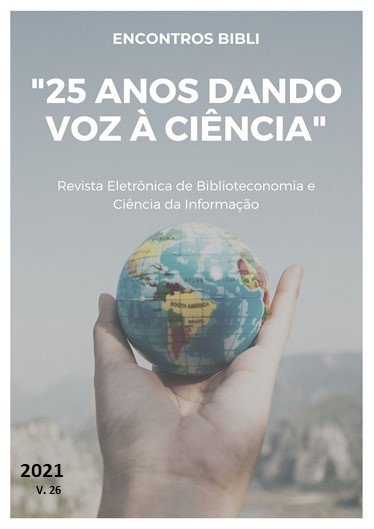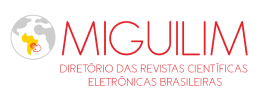Convergences between digital curation and information design in the post custodial context of information science
DOI:
https://doi.org/10.5007/1518-2924.2021.e78692Keywords:
Information and technology, Digital curation, Information designAbstract
Objective: Identify the approximations between Digital Curation (DC) and Information Design (ID) in the context of Information Science (IS) and point out the contributions of these convergences to the efficiency and effectiveness of information curation on Web environments.
Methodology: The methodology applied theoretical and exploratory with a qualitative approach, from bibliographic searches and systematization of the retrieved data. Thus, the main concepts of DC and ID as disciplines in the context of IS were retrieved, the convergences between the disciplines in the context of IS as an interdisciplinary area were presented and discussed.
Results: The curation of digital information according to the criteria of the DC provides subsidies to improve the processes of each stage of its life cycle. ID and its dimensions, in turn, subsidize the planning and development of digital environments with a focus on improving the efficiency and effectiveness of the information communicated. In the theoretical-practical scope, the convergences between the actions of DC and the dimensions of ID provide opportunities for their multidirectional complementation.
Considerations: The convergences between DC and the ID were demonstrated by the combination of elements present in subgroups of DC actions with elements present in the systematization of the ID in dimensions. There were points in common between the two disciplines that indicate the need for the convergence of their resources in the search for solutions to problems involved in the curation of digital information. The hypothesis that the two disciplines converge and potentialize solutions of complex informational problems in this context is confirmed.
Downloads
References
ARAÚJO, C. A. Á. Arquivologia, Biblioteconomia, Museologia e Ciência da Informação: O Diálogo Possível. Brasília; São Paulo: Briquet de Lemos, 2014.
ARAÚJO, C. A. Á. O que é Ciência da Informação. Belo Horizonte: KMA, 2018.
BORKO, H. Information science: what is it?. American documentation, v. 19, n. 1, p. 3-5, 1968. Disponível em: https://onlinelibrary.wiley.com/doi/abs/10.1002/asi.5090190103. Acesso em: 16 de mar. 2021.
CARLINER, S. Physical, cognitive, and affective: a three-part framework for information design. Technical Communication, Washington, v. 47, n. 4, p. 561-576. 2000. Disponível em: https://pdfs.semanticscholar.org/daf3/b3f8c7fc73d1387116bfe1211f48a9a0bc13.pdf. Acesso em: 16 de mar. 2020.
DCC - DIGITAL CURATION CENTER. What is digital curation? Edinburgh, 2019. Disponível em: http://www.dcc.ac.uk/digital-curation/what-digital-curation. Acesso em 10 de mai. 2020.
HIGGINS, S. The DCC Curation Lifecycle Model. International Journal of Digital Curation, v. 3, n. 1, p. 134-140. 2008. Disponível em: http://www.ijdc.net/article/view/69/48. Acesso em: 21 de mar. 2020.
HIGGINS, Sarah. Digital curation: the emergence of a new discipline. International Journal of Digital Curation, v. 6, n. 2, p. 78-88, 2011. Disponível em: http://www.ijdc.net/article/view/184. Acesso em: 10 de mar. 2021.
HIGGINS, S. Digital curation: the development of a discipline within information science. Journal of Documentation, 2018. Disponível em: https://www.emerald.com/insight/content/doi/10.1108/JD-02-2018-0024/full/html. Acesso em: 10 de mar. 2021.
HORN, R. Information design: emergence of a new profession. In: R. Jacobson (Org.). Information Design. Cambridge, Massachusetts: The MIT Press, 1999.
JACOBSSON, R. Information Design. Cambridge, Massachusetts: The MIT Press, 1999.
JORENTE, M. J. V. (Org.) Tecnologia e design da informação: interdisciplinaridades e novas perspectivas para a Ciência da Informação. Bauru, São Paulo: Canal 6, 2015.
JORENTE, M. J. V. Ciência da Informação: mídia, e convergência de linguagens na Web. São Paulo: Cultura Acadêmica, 2012. Disponível em: http://www.santoandre.sp.gov.br/pesquisa/ebooks/343451.pdf. Acesso em: 10 de mar. 2020.
JORENTE, M. J. V; BATISTA, L. S. O. Conversações entre a rede social twitter e os arquivos permanentes: um estudo de Curadoria Digital. Inf. Inf., Londrina, v. 22, n. 1, p. 05 – 33, 2017. Disponível em: http://www.uel.br/revistas/uel/index.php/informacao/article/view/23466. Acesso em: 12 de mai. 2020.
KAHN, K. O papel do design da informação na curadoria digital de sistemas memoriais: um estudo do museu da pessoa. 2018. 169 f. Dissertação (mestrado) - Universidade Estadual Paulista Júlio de Mesquita Filho, Faculdade de Filosofia e Ciências, 2018. Disponível em: http://hdl.handle.net/11449/153993. Acesso em: 12 de mai. 2020.
MORIN, E. Ciência com consciência. Bertrand Brasil. Rio de Janeiro 2005.
MORIN, E. A cabeça bem-feita: repensar a reforma, reformar o pensamento. Tradução Eloá Jacobina. Rio de Janeiro: Bertrand Brasil, 2003.
NAKANO, N. Princípios do design da informação na curadoria digital de ambientes virtuais de aprendizagem sob a perspectiva da ciência da informação. 2019. 165 f. Tese (Doutorado) - Universidade Estadual Paulista Júlio de Mesquita Filho, Faculdade de Filosofia e Ciências, 2019. Disponível em: http://hdl.handle.net/11449/181518. Acesso em: 12 de mai. 2020.
NHACUONGUE, J. A.; FERNEDA, E. O campo da ciência da informação: contribuições, desafios e perspectivas. Perspect. ciênc. inf., Belo Horizonte , v. 20, n. 2, p. 3-18, Jun 2015 . Dispinpivel em: http://www.scielo.br/scielo.php?script=sci_arttext&pid=S1413-99362015000200003&lng=en&nrm=iso. Acesso em: 27 de dez. 2020.
PÁDUA, M.C. Design da informação e interação: compartilhamento de informações em ambientes digitais de museus. 2019. 200 f. Tese (Doutorado) - Universidade Estadual Paulista Júlio de Mesquita Filho, Faculdade de Filosofia e Ciências, 2019. Disponível em: http://hdl.handle.net/11449/181306. Acesso em: 12 de mai. 2020.
PETTERSSON, R. It depends: id – principles and guidelines. Institute for Infology, Tullinge, Sweden, 2020a. Disponível em: https://www.researchgate.net/publication/281810734_11_It_Depends. Acesso em: 10 de mar. 2021.
PETTERSSON, R. ID concepts. Institute for Infology, Tullinge, Sweden: Institute for infology, 2020b. Disponível em: https://www.researchgate.net/publication/281810730_12_ID-concepts. Acesso em: 10 de mar. 2021.
PETTERSSON, Rune. ID Theories. Institute for Infology, Tullinge, Sweden, 2020c. Disponível em: https://www.researchgate.net/publication/307589451_2_ID_Theories. Acesso em: 10 de mar. 2021.
REDIG, J. Não há cidadania sem informação, nem informação sem design. Infodesign, v.1,n.1. [s.l.] p. 58-66, 2004. Disponível em: https://www.infodesign.org.br/infodesign/article/view/4. Acesso em: 10 maio 2020.
SARACEVIC, T. Ciência da Informação: origem, evolução e relações. Perspectivas em Ciência da Informação, Belo Horizonte, v. 1, n.1, p. 41-62, jan./jun., 1996. Disponível em: http://portaldeperiodicos.eci.ufmg.br/index.php/pci/article/view/235. Acesso em: 13 de abr. 2020.
SILVA, S. C; JORENTE, M. J. V. Design da Informação na Curadoria Digital de acervos museológicos. Múltiplos olhares em Ciência da Informação, Ed. Especial, 2018. Disponível em: http://portaldeperiodicos.eci.ufmg.br/index.php/moci/article/view/3769. Acesso em: 12 de abr. 2020.
TUFTE, E. The visual display of quantitative information. Cheshire: Graphic Press, 2001.
OLIVEIRA, J. A. D. B.; JORENTE, M. J. V. Design da Informação e Ciência Da Informação: uma aproximação possível. João Pessoa: XVI Encontro Nacional de Pesquisa em Ciência da Informação, 2015. Disponível em: https://www.brapci.inf.br/index.php/article/download/43876. Acesso em: 08 de mar. 2020.
O’REILLY, T. What is Web 2.0: Design Patterns and Business Models for the Next Generation of Software. 2005. Disponível em: http://www.oreilly.com/pub/a/web2/archive/what-is-web-20.html. Acesso em: 10 de Mai. 2020.
Downloads
Published
How to Cite
Issue
Section
License
Copyright (c) 2021 Maria Jorente, Laís Landim , Simão Apocalypse

This work is licensed under a Creative Commons Attribution 4.0 International License.
The author must guarantee that:
- there is full consensus among all the coauthors in approving the final version of the document and its submission for publication.
- the work is original, and when the work and/or words from other people were used, they were properly acknowledged.
Plagiarism in all of its forms constitutes an unethical publication behavior and is unacceptable. Encontros Bibli has the right to use software or any other method of plagiarism detection.
All manuscripts submitted to Encontros Bibli go through plagiarism and self-plagiarism identification. Plagiarism identified during the evaluation process will result in the filing of the submission. In case plagiarism is identified in a manuscript published in the journal, the Editor-in-Chief will conduct a preliminary investigation and, if necessary, will make a retraction.
This journal, following the recommendations of the Open Source movement, provides full open access to its content. By doing this, the authors keep all of their rights allowing Encontros Bibli to publish and make its articles available to the whole community.
Encontros Bibli content is licensed under a Creative Commons Attribution 4.0 International License.
Any user has the right to:
- Share - copy, download, print or redistribute the material in any medium or format.
- Adapt - remix, transform and build upon the material for any purpose, even commercially.
According to the following terms:
- Attribution - You must give appropriate credit, provide a link to the license, and indicate if changes were made. You may do so in any reasonable manner, but not in any way that suggests the licensor endorses you or your use.
- No additional restrictions - You may not apply legal terms or technological measures that legally restrict others from doing anything that the license permits.

























